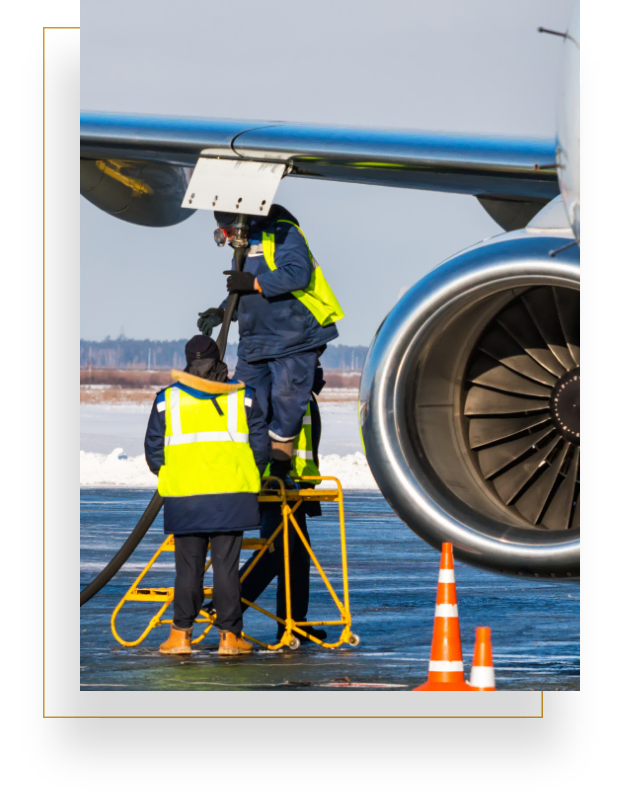Choosing The Best Aviation Fuel Supplier for Your Next Destination

Efficiency and Safety
in Each Aircraft Refueling Process
Fueling efficiency has never been more critical than it is today. Delays due to fueling inefficiency can impact everything from customer experience to the cost of operations.
We understand the challenges in the aviation industry, and we face them with innovative approaches. We stand tall in the aviation community with our top-notch services that cover a comprehensive range of our customers’ needs from planning, flight permits, ground support, and any other trip support service.
At Jet Business Solutions, we know that not all aircraft and jets are the same and that each mission is unique. Thus, our team of experts is dedicated, up to date, and driven by focus and efficiency.
We have built a diversified network of fuel suppliers and indexes to provide high-quality fuel at competitive prices.
Our worldwide network of aviation fuel suppliers enables us to provide aircraft fueling services in most national, international, commercial, and private airports. We have partnerships with major, regional, and local aviation fuel suppliers globally.
We are always ready to offer professional and safe services that match the fueling specifications and needs of your aircraft.
Competitive Pricing for an Optimized Bottom Line
We offer premium aviation fuel services in almost every commercial and private airport, keeping in mind the aviation challenges of refueling aircraft.
One of these challenges is the fuel cost, a large direct operating cost of any flight planning. Hence, we try to save up on gallons of fuel for an optimized annual fuel bill.
We accomplish that through our vast supply chain of aviation refuelers that covers the largest airports around the world. Whether commercial aircraft, private jets, or any other kind, we choose the feedstock that complies with international standards and testing.
Our competitive aviation fuel prices are not at odds with our commitment to quality and safety.
JBS always follows safety procedures in any supply operation. The experts test the fuel’s quality and make sure there are no traces of water in it. Besides, we provide a precise protocol for the fueling process above or below the wing.
We are subject to safety regulations set by the International Air Transport Association (IATA) and the Joint Inspection Group (JIG), which cover 93% of the international aviation world
Aviation
Fueling
Frequently
Asked Questions
What is the difference between Jet A and Jet A1?
Jet A is more common in the US, while Jet A1 is more used globally. Anyway, there are two main differences:
- Freezing point:
Jet A’s freezing point is -40°C, while Jet A1 freezes at -47°. That makes Jet A1 more suitable for long flights and polar routes.
- Additives:
Jet A1 contains static dissipater additives. However, Jet-A does not always do.
How can we identify AVGAS 100 LL from other fuels?
You can recognize AVGAS 100LL at airfield distribution stations by its label with white letters on a red background. This bold identification is for avoiding any risk of confusion or “misfuelling” with AVGAS UL 91 and JET A-1.
Similarly, the AVGAS dispensing guns are red, and the JET A-1 ones are black.
Why AVGAS 100LL is more expensive than Jet A?
Jet-A production is less complicated and cheaper.
The transportation of AVGAS 100LL via pipelines is more expensive.
Aircraft use Jet-A in higher quantities which leads to economies of scale.
What are alternative fuels?
AAF/ Aviation Alternative Fuel’s main ingredients are coal, natural gas, biomass, and hydrogenated fats and oils, instead of petroleum. Thus, it has environmental benefits due to its lower carbon emissions than conventional fuel.
SAF/ Sustainable Aviation Fuel is the same as an alternative fuel, plus it meets the sustainability criteria of the Carbon Offsetting and Reduction Scheme for International Aviation.
Why are non-drop-in fuels not common?
Handling a “non-drop-in” fuel differs from conventional aviation fuel (CAF). This will arise safety issues associated with risks of mishandling and require building a suitable parallel infrastructure at all airports.
Let’s Talk Flights…